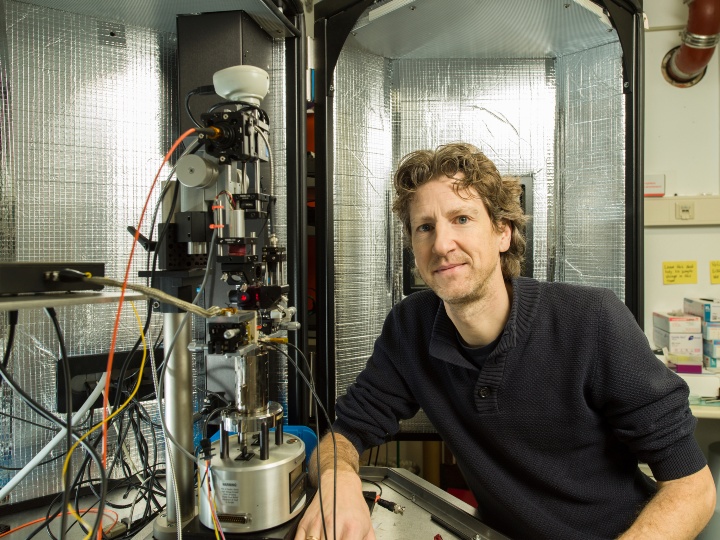In the laboratory, solar cells made of perovskite are already converting sunlight into electricity as efficiently as established silicon solar cells. Stefan Weber from the Institute for Photovoltaics (ipv) at the University of Stuttgart is now developing a new type of photovoltaic microscope to help them achieve the final breakthrough. This enables him to elucidate the function of the promising semiconductor material at the nanostructure level for the first time. He has been awarded an ERC Consolidator Grant from the European Research Council (ERC), receiving nearly three million euros in funding for his "NanoPLOT" project.
Perovskite is not a specific chemical substance, but a group of materials with a typical crystal structure. Professor Stefan Weber from the Institute for Photovoltaics (ipv) is researching this material, as it is ideal for use as a light absorber in solar cells. "Perovskite solar cells offer clear advantages over the established semiconductor material, silicon, both functionally and economically," explains Weber.
What makes perovskite so good
Perovskite solar cells are cheaper than the solar cells currently on the market, as the energy required to manufacture them is much lower. The composition of perovskite can also be varied, meaning that important properties such as the band gap can be adjusted as required. The band gap determines how much of the sunlight's energy can be absorbed and in which range of the solar spectrum the solar cell works particularly efficiently. However, there are also disadvantages, explains Weber: "Defects in the microscopic crystal structure of a perovskite solar cell can lead to energy losses. Some of these defects slow down the flow of electrons excited by sunlight, while others lead to premature ageing effects in the cells."
Twins as barriers
From September, Weber will be researching the causes of these weaknesses as part of the "NanoPLOT" project as a receiver of the ERC Consolidator Grant. The Stuttgart ipv boasts world-class equipment, making it the ideal location for this research. And last but not least, Institute Director Prof. Michael Saliba is also an ERC-funded perovskite expert.
Weber aims to discover the following: Which types of defects are found where in the cell? And what effect do these have on their efficiency? And how are the individual defect types involved in the premature ageing of MHP cells? This is no easy task, because the structures that generate the energy losses are all micro- and nanostructures, i.e. very, very small. A perovskite layer, for example, consists of many crystals just a few hundred nanometers in size. "These all behave like individual mini solar cells," explains Weber. The gaps between the crystal grains contain a particularly large number of harmful defects, which could be the cause of an accelerated decline in cell performance. Another problem that Weber has been researching for years: Twin domains. These tiny pairs of strips, whose crystal symmetry runs in exactly opposite directions, presumably form barriers for the electrons, which they have to overcome - making them slower.
New microscopic combination
In order to track down the tiny culprits, Weber is making these processes visible in the nanometer range for the first time. To do this, he combines two methods: Atomic force microscopy (AFM) and optical spectroscopy. In atomic force microscopy, a tiny, sharp tip hovers above the solar cell. It measures two to ten nanometers and is therefore around ten thousand times thinner than a human hair. The interaction between the atoms at the tip end and the atoms on the surface creates weak forces that deflect the tip upwards or downwards. This allows the structure and electrical charge on the surface of the solar cell to be measured with nanometer precision. However, this information is not sufficient to obtain a complete picture, which is why optical spectroscopy is also being used - in a way that has not yet been tested.
The trick: Weber directs electricity to the solar cell via the AFM tip, which generates light there. This effect is called electroluminescence. The illuminated areas can then be examined with an optical microscope. "This gives me information about local defects that are directly related to energy losses. And with a spatial resolution that is no longer limited by the optics, but only by the size of the nano-tip," explains Weber.

Perovskite-silicon tandem increases efficiency
Weber also wants to use electroluminescence to observe the causes of the instability of perovskite solar cells at the nano level. The knowledge gained is intended to advance the development of more powerful, more stable, and highly scalable perovskite cells. In particular, the lower production costs compared to silicon solar cells could help with market entry. "The new technology must demonstrate a clear and significant advantage to prevail over the old one. After all, silicon solar cells represent a billion-dollar market." Another advantage of perovskites is their compatibility with silicon. Such tandem solar cells are already able to achieve an efficiency of up to 33 percent. This means that one third of the sunlight is converted into electricity. According to Weber, tandems could shake up the photovoltaic market in the near future and give the energy transition another major boost. Weber hopes that his project will make a valuable contribution to this.
About the ERC Consolidator Grant
The ERC Consolidator Grant is awarded by the European Research Council to support outstanding and promising scientists from all disciplines who are seven to twelve years post-doctorate and in the consolidation phase of establishing their own independent research group. It provides up to two million euros, with the possibility of additional start-up funding, for a duration of five years.
Award-winning researchers
Every year, numerous researchers at the University of Stuttgart are honored for groundbreaking and creative achievements.
Expert Contact:
Prof. Stefan Weber, University of Stuttgart, Institute for Photovoltaics Tel.: +49 711 685-69209, email
Are you looking for expert contacts in a specific field? The Expert Service at the University of Stuttgart helps you find scientists who can support you in your research.
Media contact

Lydia Lehmann
Deputy Head of University Communications


